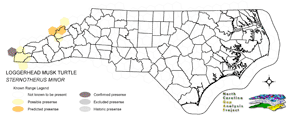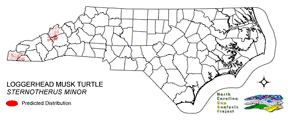
| Taxa: |
| Order: |
| Family: |
| Reptilia |
| Testudines |
| Kinosternidae |
| NatureServe Global Rank: |
| NatureServe State (NC) Rank: |
| G5 |
| S1 |
| Federal Status: |
| NC State Status: |
| --- |
| SC |


| Land Unit |
| US Fish & Wildlife Service |
| US Forest Service |
| US National Park Service |
| US Department of Defense |
| NC State Parks |
| NC University System |
| NC Wildlife Res. Com. |
| NC Forest Service |
| NC Div. of Coastal Mgmt. |
| Local Governments |
| Non-Governmental Org. |
| Other Public Lands |
| Private Lands |
| GAP Status 1-2 |
| All Protected Lands |
| Statewide |
| Hectares |
| 0.00 |
| 3,180.33 |
| 0.00 |
| 0.00 |
| 0.00 |
| 0.00 |
| 0.00 |
| 0.00 |
| 0.00 |
| 0.00 |
| 2.34 |
| 0.00 |
| 45,373.05 |
| 30.06 |
| 3,182.67 |
| 48,555.72 |
| Acres |
| 0.00 |
| 7,858.77 |
| 0.00 |
| 0.00 |
| 0.00 |
| 0.00 |
| 0.00 |
| 0.00 |
| 0.00 |
| 0.00 |
| 5.78 |
| 0.00 |
| 112,119.23 |
| 74.28 |
| 7,864.55 |
| 119,983.77 |
| % of Dist. on |
| Prot. Lands |
| 0.0 % |
| 99.9 % |
| 0.0 % |
| 0.0 % |
| 0.0 % |
| 0.0 % |
| 0.0 % |
| 0.0 % |
| 0.0 % |
| < 0.1 % |
| < 0.1 % |
| 0.0 % |
| 0.0 % |
| 0.9 % |
| ----- |
| ----- |
| % of Dist. on |
| All Lands |
| 0.0 % |
| 6.5 % |
| 0.0 % |
| 0.0 % |
| 0.0 % |
| 0.0 % |
| 0.0 % |
| 0.0 % |
| 0.0 % |
| 0.0 % |
| < 0.1 % |
| 0.0 % |
| 93.4 % |
| < 0.1 % |
| ----- |
| ----- |
|
In North Carolina, a few have been captured near Tennessee along valley areas of westward flowing mountain rivers and streams (Palmer and Braswell 1995). The loggerhead musk turtle is associated with running water or with semi- and permanent bodies of water connected with running water, such as oxbow lakes and riparian pools (Tinkle 1958). Populations appear to be concentrated at areas along rivers and streams where the water deepens and slows, and where sand, silt and loose debris are deposited on the bottom (Palmer and Braswell 1995). However, it is rarely found in farm ponds and other isolated waters. In Virginia, they occur in areas with aquatic and overhanging vegetation, rock cover, and soft substrates (Mitchell 1994). They are bottom walkers and seldom bask (Mitchell and Pague 1987). They occur commonly around snags and fallen trees and prefer a soft substrate (Ernst and Barbour 1972). NATURE SERVE GLOBAL HABITAT COMMENTS: Rivers, creeks, spring runs, oxbows, swamps, ponds, shallow lake margins, canals; areas with a soft bottom. Bottom dweller, often near rocks, logs, or plant cover. Climbs into tree branches to bask. Often travels overland. Nests have been found in Florida woods at bases of stumps and logs (Ernst and Barbour 1972). |
| Code | Name | Description | NC Natural Heritage Program Equivalent |
| 238 | Piedmont/Mountain Submerged Aquatic Vegetation | Seasonally to permanently flooded areas with aquatic vegetation. Waterlily, pondweed, hydrilla smartweed are a few of the species that can occur. | Piedmont/Mountain Semipermanent Impoundment (in part) |
| 239 | Piedmont/Mountain Emergent Vegetation | Emergent vegetation of all wetland hydrologies. Sites would commonly support species such as tussock sedge, rushs, and cattail alliances. | Rocky Bar and Shore (in part) |
| 267 | Riverbank Shrublands | Riverside shrubs with temporarily flooded hydrologies. Found in the both the Mountains and Piedmont. Containing dominants such as smooth alder and a Carolina or black willows. | Sand and Mud Bar |
| 384 | Piedmont/Mountain Mixed Bottomland Hardwood Forests | Includes temporarily to seasonally forests dominated by hardwood species. Hardwoods include sweetgum, red maple, sycamore which co-occur in a mosaic of bottomland and levee positions. Includes alluvial hardwood forests in the mountains. Hemlock and white pine may occur as inclusions, but are generally mapped separately. | Piedmont/Mountain Alluvial Forest, Piedmont/Mountain Levee Forest |
| 383 | Piedmont Mixed Successional Forest | Generally loblolly mixed with successional hardwoods. Sweetgum, tulip poplar and red maple are common co-dominants in these successional forests. | No equivalent |
| 180 | Agricultural Crop Fields | Farm fields used for row crops. | No equivalent |
| 205 | Agricultural Pasture/Hay and Natural Herbaceous | Farm fields used for pasture grass or hay production, as well as old fields dominated by native and exotic grasses. | No equivalent |
| 8 | Open water | Open water without aquatic vegetation. | No equivalent |
| 517 | Hemlock Floodplain Forest | Alluvial forest with hemlock and/or white pine in mountains and western piedmont. Hydrology is generally temporarily to seasonally flooded. | Canada Hemlock Forest |
| 527 | Appalachian Hemlock | Upland hemlock forests of the moutains region. Vary from side slopes to steep slope positions. | Canada Hemlock Forest |
|
Mitchell, J. C. 1994. The reptiles of Virginia. Washington, DC: Smithsonian Institution Press. Palmer, W. M., and A. L. Braswell. 1995. Reptiles of North Carolina. North Carolina State Museum of Natural Sciences, University of North Carolina Press, Chapel Hill, North Carolina. Iverson, J. B. 1977. Sternotherus minor. Cat. Am. Amph. Rep. 195.1-195.2. Ernst, C. H., and R. W. Barbour. 1972. Turtles of the United States. Univ. Press of Kentucky, Lexington. x + 347 pp. Ashton, R. E., Jr., and P. S. Ashton. 1985. Handbook of reptiles and amphibians of Florida. Part two. Lizards, turtles & crocodilians. Windward Pub., Inc., Miami. 191 pp. Seidel, M. E., J. B. Iverson, and M. D. Adkins. 1986. Biochemical comparisons and phylogenetic relationships in the family Kinosternidae (Testudines). Copeia 1986:285-294. Etchberger, C. R., and L. M. Ehrhart. 1987. The reproduc- tive biology of the female loggerhead musk turtle, STERNOTHERUS MINOR MINOR, from the southern part of its range in central Florida. Herpetologica 43:66-73. Cox, W. A., et al. 1991. A model for growth in the musk turtle, STERNOTHERUS MINOR, in a north Florida spring. Copeia 1991:954-968. Ernst, C. H., and R. W. Barbour. 1989. Turtles of the world. Smithsonian Institution Press, Washington, D.C. xii + 313 pp. King, F. W., and R. L. Burke, editors. 1989. Crocodilian, tuatara, and turtle species of the world:a taxonomic and geographic reference. Association of Systematics Collections, Washington, D.C. 216 pp. Collins, J. T. 1990. Standard common and current scientific names for North American amphibians and reptiles. SSAR Herpetol. Circular No. 19. 41 pp. Iverson, J. B. 1991. Phylogenetic hypotheses for the evolution of modern kinosternine turtles. Herpetological Monographs 5:1-27. |
For more information please contact them at:
NC-GAP Analysis Project
Dept. of Zoology, NCSU
Campus Box 7617
Raleigh, NC 27695-7617
(919) 513-2853
www.basic.ncsu.edu/ncgap